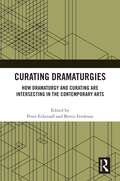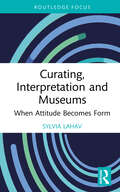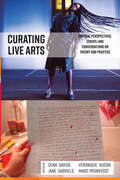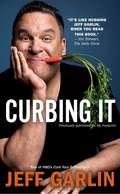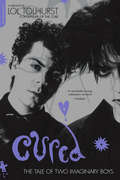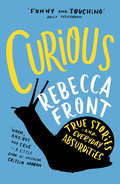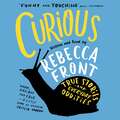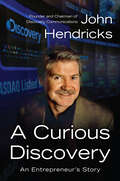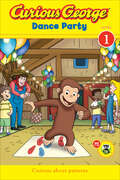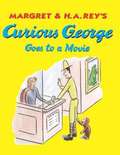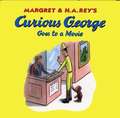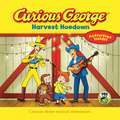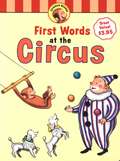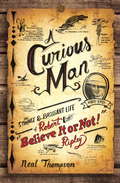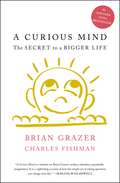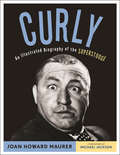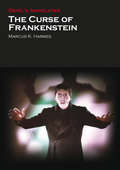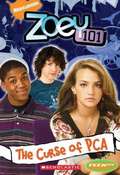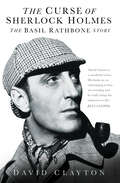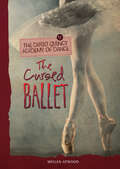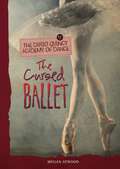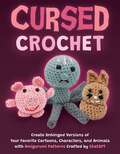- Table View
- List View
Curating Dramaturgies: How Dramaturgy and Curatorial Practices are Intersecting in the Contemporary Arts
by Peter Eckersall Bertie FerdmanCurating Dramaturgies investigates the transformation of art and performance and its impact on dramaturgy and curatorship. Addressing contexts and processes of the performing arts as interconnecting with visual arts, this book features interviews with leading curators, dramaturgs and programmers who are at the forefront of working in, with, and negotiating the daily practice of interdisciplinary live arts. The book offers a view of praxis that combines perspectives on theory and practice and looks at the way that various arts institutions, practitioners and cultural agents have been working to change the way that art and performance have developed and experienced by spectators in the last decade. Curating Dramaturgies argues that cultural producers and scholars are becoming more cognizant of this overlapping and transforming field. The introductory essay by the editors explores the rise of interdisciplinary live arts and its ramifications in cultural and political terms. This is further elaborated in the interviews with 15 diversely placed arts professionals who are at the forefront of rethinking and consolidatingthe ever-evolving field of the visual arts and performance.
Curating, Interpretation and Museums: When Attitude Becomes Form (Routledge Focus on the Global Creative Economy)
by Sylvia LahavFollowing a period of strategic and ideological change in museums, this book outlines new attitudes in curating and display, education and learning, text and interpretation, access, inclusion, participation, space, and the issues around the sustainability of the encyclopaedic collection. Focused on the contemporary period, the author questions the extent to which the museum visitor has become reliant on interpretative text and examines the development of new museum spaces where visitor interaction and engagement is welcomed. Changes of attitude have transformed our museums into modern spaces that reflect current needs and modern expectations and yet our permanent collections remain relatively unchanged, sometimes an uncomfortable reminder of a time when values, ethics, and attitudes were very different. The author will discuss these conflicts of ideology. Written by a researcher with expertise in museum practice, this shortform book offers a new approach that will be valuable reading for students and scholars of cultural management and policy, as well as providing insights for reflective museum practitioners.
Curating Live Arts: Critical Perspectives, Essays, and Conversations on Theory and Practice
by Dena Davida Marc Pronovost Véronique Hudon Jane GabrielsSituated at the crossroads of performance practice, museology, and cultural studies, live arts curation has grown in recent years to become a vibrant interdisciplinary project and a genuine global phenomenon. Curating Live Arts brings together bold and innovative essays from an international group of theorist-practitioners to pose vital questions, propose future visions, and survey the landscape of this rapidly evolving discipline. Reflecting the field’s characteristic eclecticism, the writings assembled here offer practical and insightful investigations into the curation of theatre, dance, sound art, music, and other performance forms—not only in museums, but in community, site-specific, and time-based contexts, placing it at the forefront of contemporary dialogue and discourse.
Curbing It: Carrying the Weight of the World
by Jeff GarlinNow in paperback from comedian and actor Jeff Garlin--who plays Larry David's cheerful manager on HBO's Curb Your Enthusiasm--a year-long chronicle of his journey to reduce both his physical and carbon footprint in this laugh-out-loud self-experimental memoir. Jeff Garlin has dedicated the filming of an entire season of Curb Your Enthusiasm to completely making over his lifestyle in two major ways--by losing weight and going green. Larry David's rooting for him. Jerry Seinfeld's plotting against him. And his wife is just plain annoyed by everything. The hardest part of the endeavor is overcoming his food addiction--especially when craft service has a constant buffet of everything delicious you could imagine. In addition to cutting calories, Jeff accidentally falls into a love affair with pilates, sweats with Richard Simmons, and twice visits the Pritikin Longevity Center, which he says is "rehab for people who eat too much pizza." As far as going green, Jeff has always been a big recycler, but he has a lot to learn. For example, actor Ed Begley Jr. is the guy to call if you want to reduce your environmental impact. Jeff does, and it changes everything. Hysterical, entertaining, and eye-opening, Curbing It is a comedic memoir that's not to be missed.
Cured: The Tale of Two Imaginary Boys
by Lol Tolhurst"On our first day of school, Robert and I stood at the designated stop at Hevers Avenue with our mothers, and that's when we met for the very first time. We were five years old."So began a lifelong friendship that fourteen years later would result in the formation of The Cure, a quintessential post-punk band whose albums-such as Three Imaginary Boys, Pornography, and Kiss Me, Kiss Me, Kiss Me-remain among the best-loved and most influential of all time.As two of the first punks in the provincial English town of Crawley, Lol Tolhurst and Robert Smith didn't have it easy. Outsiders from the start, theirs was a friendship based initially on proximity and a shared love of music, from the punk that was raging in nearby London to the groundbreaking experimentation of David Bowie's "Berlin Trilogy." First known as The Easy Cure, they began playing in pubs and soon developed their own unique style and approach to songwriting, resulting in timeless songs that sparked a deep sense of identification and empathy in listeners, songs like "Boys Don't Cry," "Just Like Heaven," and "Why Can't I Be You?," spearheading a new subculture dubbed "Goth" by the press. The music of The Cure was not only accessible but also deeply subversive, challenging conventional notions of pop music and gender roles while inspiring a generation of devoted fans and a revolution in style.Cured is not only the first insider account of the early days of the band, it is a revealing look at the artistic evolution of the enigmatic Robert Smith, the iconic lead singer, songwriter, and innovative guitarist at the heart of The Cure. A deeply rebellious, sensitive, tough, and often surprisingly "normal" young man, Smith was from the start destined for stardom, a fearless non-conformist and provocateur who soon found his own musical language through which to express his considerable and unique talent.But there was also a dark side to The Cure's intense and bewildering success. Tolhurst, on drums and keyboards, was nursing a growing alcoholism that would destroy his place in The Cure and nearly end his life. Cured tells the harrowing and unforgettable story of his crash-and-burn, recovery, and rebirth.Intensely lyrical and evocative, gripping and unforgettable, Cured is the definitive story of a singular band whose legacy endures many decades hence, told from the point of view of a participant and eyewitness who was there when it happened-and even before it all began.
Curious: True Stories and Loose Connections
by Rebecca Front'Warm, anxious and true - a Little Book of Un-Calm' Caitlin MoranShortlisted for Non-Fiction Book of the Year at the National Book AwardsSometimes things are more ordinary than you think. And sometimes they're a whole lot odder than you can possibly imagine. By turns poignant, comic and uplifting, Curious is a book of stories from Rebecca Front's life, all of them true, though sometimes perhaps a little bent out of shape in the telling. It is a beguiling celebration of the curiosities of everyday life, and of what it is to be curious - in every sense of the word.
Curious: True Stories and Loose Connections
by Rebecca Front'Warm, anxious and true - a Little Book of Un-Calm' Caitlin MoranShortlisted for Non-Fiction Book of the Year at the National Book AwardsSometimes things are more ordinary than you think. And sometimes they're a whole lot odder than you can possibly imagine. By turns poignant, comic and uplifting, Curious is a book of stories from Rebecca Front's life, all of them true, though sometimes perhaps a little bent out of shape in the telling. It is a beguiling celebration of the curiosities of everyday life, and of what it is to be curious - in every sense of the word.
Curious: True Stories and Loose Connections
by Rebecca FrontNarrated by the author, and featuring an interview with Jeremy Front.Sometimes things are more ordinary than you think. And sometimes they're a whole lot odder than you can possibly imagine. Rebecca Front has always drawn on experiences from her life in her award-winning acting and comic writing. In her debut book, she reveals herself as a master storyteller: sharp, witty, honest and highly attuned to the absurdities of life and the oddities of human nature. By turns poignant, comic and uplifting, CURIOUS is a book of stories, all of them true, though sometimes perhaps a little bent out of shape in the telling. We learn, among other things, why a Mexican wave is a symbol of oppression, how to navigate a conversational cul-de-sac with a French vegan train driver, and why keeping a pet rabbit on a lead is perfectly normal.This is a beguiling celebration of the curiosities of everyday life, and of what it is to be curious - in every sense of the word.(p) 2014 Orion Publishing Group
A Curious Discovery: An Entrepreneur's Story
by John S. HendricksIn A Curious Discovery, media titan John Hendricks tells the remarkable story of building one of the most successful media empires in the world, Discovery Communications.John Hendricks, a well-respected corporate leader and brand builder, reveals that his professional achievements would not have been possible without one crucial quality that has informed his life since childhood: curiosity. This entrepreneur’s story takes you behind the scenes of some of the network’s most popular shows and greatest successes, and imparts crucial lessons from the network’s setbacks.With insights, anecdotes, photographs, and real-world wisdom, A Curious Discovery is more than a powerful autobiography and corporate history: It also a valuable primer for business innovators and entrepreneurs.
Curious George Dance Party (Curious George Ser.)
by H. A. Rey H. A. ReyGeorge is thrilled when he gets an invitation to Allie’s dance party: “He danced while he brushed his teeth. Sometimes he even danced while he slept.” His friend Bill, however, is worried he’ll be the only one who can’t dance. The two of them quickly learn the box step with the help of a color-coded map—and it’s a hit! This colorful early reader—based on the Emmy Awardwinning Curious George PBS TV show—includes a simple pattern activity and instructions on how to make a dance map. For more monkey fun, investigate www.curiousgeorge.com and discover all the latest on Curious George books, promotions, games, activities, and more!
Curious George Goes to a Movie
by Margret ReyWhen his curiosity leads him to investigate how the movie gets onto the screen, George, an inquisitive monkey, disrupts the show. Share Curious George's irresistible qualities-ingenuity, opportunity, determination, and curiosity in learning and exploring-with these easy-to-read picture books for your young readers.
Curious George Goes to the Movies
by H. A. Rey Margret ReyWhen his curiosity leads him to investigate how the movie gets onto the screen.Young readers will enjoy this picture book. Includes picture descriptions.
Curious George Harvest Hoedown (Curious George)
by H. A. ReyIn this new book based on the Emmy Award-winning PBS show, Curious George, the man with the yellow hat can’t wait to join the Uptown Bluegrass Band for a good old-fashioned country hoedown. When George accidentally ruins the man’s guitar while trying to clean it, George and Allie decide to make a new guitar! With a shoestring, rubber band, fishing wire, and yoyo, George and Allie's creation has a truly unique sound! Bonus activities help reinforce the concepts in the story, including instructions for building your very own homemade string instrument!
Curious George's First Words at the Circus
by H. A. ReyEach of these well-priced ebooks introduces readers to a new, fun location and identifies objects they might find there. These ebooks will build children's vocabulary as they follow Curious George on his trips to the zoo, circus, circus, aquarium, and farm. Bold colors, large type, and everyone's favorite mischievous monkey combine to make learning fun.
The Curious Humanist: Siegfried Kracauer in America
by Johannes Von MoltkeDuring the Weimar Republic, Siegfried Kracauer established himself as a trenchant theorist of film, culture, and modernity, and he is now considered one of the key thinkers of the twentieth century. When he arrived in Manhattan aboard a crowded refugee ship in 1941, however, he was virtually unknown in the United States and had yet to write his best-known books, From Caligari to Hitler and Theory of Film. Johannes von Moltke details the intricate ways in which the American intellectual and political context shaped Kracauer's seminal contributions to film studies and shows how, in turn, Kracauer's American writings helped shape the emergent discipline. Using archival sources and detailed readings, von Moltke asks what it means to consider Kracauer as the New York Intellectual he became in the last quarter century of his life. Adopting a transatlantic perspective on Kracauer's work, von Moltke demonstrates how he pursued questions in conversation with contemporary critics from Theodor Adorno to Hannah Arendt, from Clement Greenberg to Robert Warshow: questions about the origins of totalitarianism and the authoritarian personality; about high and low culture; about liberalism, democracy, and what it means to be human. From these wide-flung debates, Kracauer's own voice emerges as that of an incisive cultural critic invested in a humanist understanding of the cinema.
A Curious Man: The Strange and Brilliant Life of Robert "Believe It or Not!" Ripley
by Neal ThompsonA Curious Man is the marvelously compelling biography of Robert "Believe It or Not" Ripley, the enigmatic cartoonist turned globetrotting millionaire who won international fame by celebrating the world's strangest oddities, and whose outrageous showmanship taught us to believe in the unbelievable.As portrayed by acclaimed biographer Neal Thompson, Ripley's life is the stuff of a classic American fairy tale. Buck-toothed and cursed by shyness, Ripley turned his sense of being an outsider into an appreciation for the strangeness of the world. After selling his first cartoon to Time magazine at age eighteen, more cartooning triumphs followed, but it was his "Believe It or Not" conceit and the wildly popular radio shows it birthed that would make him one of the most successful entertainment figures of his time and spur him to search the globe's farthest corners for bizarre facts, exotic human curiosities, and shocking phenomena.Ripley delighted in making outrageous declarations that somehow always turned out to be true--such as that Charles Lindbergh was only the sixty-seventh man to fly across the Atlantic or that "The Star Spangled Banner" was not the national anthem. Assisted by an exotic harem of female admirers and by ex-banker Norbert Pearlroth, a devoted researcher who spoke eleven languages, Ripley simultaneously embodied the spirit of Peter Pan, the fearlessness of Marco Polo and the marketing savvy of P. T. Barnum.In a very real sense, Ripley sought to remake the world's aesthetic. He demanded respect for those who were labeled "eccentrics" or "freaks"--whether it be E. L. Blystone, who wrote 1,615 alphabet letters on a grain of rice, or the man who could swallow his own nose.By the 1930s Ripley possessed a vast fortune, a private yacht, and a twenty-eight room mansion stocked with such "oddities" as shrunken heads and medieval torture devices, and his pioneering firsts in print, radio, and television were tapping into something deep in the American consciousness--a taste for the titillating and exotic, and a fascination with the fastest, biggest, dumbest and most weird. Today, that legacy continues and can be seen in reality TV, YouTube, America's Funniest Home Videos, Jackass, MythBusters and a host of other pop-culture phenomena. In the end Robert L. Ripley changed everything. The supreme irony of his life, which was dedicated to exalting the strange and unusual, is that he may have been the most amazing oddity of all.From the Hardcover edition.
A Curious Mind: The Secret to a Bigger Life
by Brian Grazer Charles Fishman#1 New York Times bestselling author and Oscar–winning producer Brian Grazer has written a brilliantly entertaining and eye-opening exploration of curiosity and the life-changing effects it can have on every person’s life.From Academy Award–winning producer Brian Grazer, New York Times bestseller A Curious Mind offers a brilliant peek into the “curiosity conversations” that inspired him to create some of the world’s most iconic movies and television shows. He shows how curiosity has been the “secret” that fueled his rise as one of Hollywood’s leading producers and creative visionaries, and how all of us can channel its power to lead bigger and more rewarding lives. Grazer has spent most of his life exploring curiosity through what he terms “curiosity conversations” with some of the most interesting people in the world, including spies, royals, scientists, politicians, moguls, Nobel laureates, artists…anyone whose story might broaden his worldview. These discussions sparked the creative inspiration behind many of his movies and TV shows, including Splash, 24, A Beautiful Mind, Apollo 13, Arrested Development, 8 Mile, J. Edgar, Empire, and many others. A Curious Mind is not only a fascinating page-turner—it also offers a blueprint for how we can awaken our own curiosity and use it as a superpower in our lives. Whether you’re looking to strengthen your management style at work, uncover a new source of creativity, or become a better romantic partner, this book—and its lessons on the power of curiosity—can change your life.
Curly: An Illustrated Biography of the Superstooge
by Michael Jackson Joan Howard MaurerWhile the Three Stooges were the longest active and most productive comedy team in Hollywood, their artistic height coincided with the years Curly was with them, and this is his definitive biography. From 1932 to 1946 Curly was the zaniest of the Stooges, becoming famous for his high-pitched voice, his "nyuk-nyuk-nyuk" and "why, soitenly," and his astonishing athleticism. He was a true natural, an untrained actor with a knack for improvisation, yet for decades, little information about him was available. Curly's niece Joan Howard Maurer amassed a wealth of Curly memorabilia--a mixture of written material and rare photographs of Curly's family, films, and personal life--and her exhaustive research and exclusive interviews resulted in this first and only in-depth look at a crazy comedic genius. Plenty of intimate details are included about his astonishing relationship with his mother, his three marriages, and his interactions with his daughters and friends. The book was so beloved among Three Stooges fans that it even garnered a foreword from Michael Jackson, the King of Pop himself. This new, redesigned edition of a timeless classic is sure to be appreciated by Three Stooges fans new and old.
The Curse of Frankenstein (Devil's Advocates)
by Marcus HarmesCritics abhorred it, audiences loved it, and Hammer executives where thrilled with the box office returns: The Curse of Frankenstein was big business. The 1957 film is the first to bring together in a horror movie the 'unholy two', Christopher Lee and Peter Cushing, together with the Hammer company, and director Terence Fisher, combinations now legendary among horror fans. In his Devil's Advocate, Marcus Harmes goes back to where the Hammer horror production started, looking at the film from a variety of perspectives: as a loose literaryadaptation of Mary Shelley's novel; as a film that had, for legal reasons, to avoid adapting from James Whale's 1931 film for Universal Pictures; and as one which found immediate sources of inspiration in the Gainsborough bodice rippers of the 1940s and the poverty row horrors of the 1950s. Later Hammer horrors may have consolidated the reputation of the company and the stars, but these works had their starting point in the creative and commercial choices made by the team behind The Curse of Frankenstein. In the film sparks fly, new life is created and horrors unleashed but the film itself was a jolt to 1950s cinema going that has never been entirely surpassed.
The Curse of Frankenstein
by Marcus K. HarmesCritics abhorred it, audiences loved it, and Hammer executives where thrilled with the box office returns: The Curse of Frankenstein was big business. The 1957 film is the first to bring together in a horror movie the 'unholy two', Christopher Lee and Peter Cushing, together with the Hammer company, and director Terence Fisher, combinations now legendary among horror fans. In his Devil's Advocate, Marcus Harmes goes back to where the Hammer horror production started, looking at the film from a variety of perspectives: as a loose literaryadaptation of Mary Shelley's novel; as a film that had, for legal reasons, to avoid adapting from James Whale's 1931 film for Universal Pictures; and as one which found immediate sources of inspiration in the Gainsborough bodice rippers of the 1940s and the poverty row horrors of the 1950s. Later Hammer horrors may have consolidated the reputation of the company and the stars, but these works had their starting point in the creative and commercial choices made by the team behind The Curse of Frankenstein. In the film sparks fly, new life is created and horrors unleashed but the film itself was a jolt to 1950s cinema going that has never been entirely surpassed.
The Curse of PCA (Zoey #101)
by Jane Mason Sarah Hines StephensZoey and the gang are back for another year of laughs, friendship, pranks, and drama at PCA, in this latest chapter book based on the hit Nickelodeon show.
The Curse of Sherlock Holmes: The Basil Rathbone Story
by David ClaytonBasil Rathbone is synonymous with Sherlock Holmes.He played the Victorian sleuth in the fourteen Fox/Universal films of the 1930s and ’40s, as well as on stage and radio. For many people, he is the Holmes.Basil Rathbone grew to hate Sherlock Holmes.The character placed restrictions on his career: before Holmes he was an esteemed theatre actor, appearing in Broadway plays such as The Captive and The Swan, the latter of which became his launchpad to greater stardom. But he never, ever escaped his most famous role.Basil Rathbone was not Sherlock Holmes.In The Curse of Sherlock Holmes, celebrated biographer David Clayton looks at the behind-the-camera life of a remarkable man who deserved so much more than to be relegated to just one role.
The Cursed Ballet (The\dario Quincy Academy Of Dance Ser. #3)
by Megan AtwoodEvery time the Dario Quincy Academy has performed Giselle, the ballet's lead dancer has died. That's what the rumors say, anyway. But Ophelia doesn't believe in all that. She's determined to win the lead and beat the so-called curse. As Ophelia begins sneaking out at night to practice Giselle's moves, she meets a mysterious boy hiding in the shadows. He's got great moves, and his looks aren't bad either. After a series of secret meetings, Ophelia starts to feel drained of her strength. She even blacks out during dance class. Is she just pushing herself too hard? Or are the boy and the curse connected?
The Cursed Ballet (The Dario Quincy Academy of Dance #3)
by Megan AtwoodEvery time the Dario Quincy Academy has performed Giselle, the ballet's lead dancer has died. That's what the rumors say, anyway. But Ophelia doesn't believe in all that. She's determined to win the lead and beat the so-called curse. As Ophelia begins sneaking out at night to practice Giselle's moves, she meets a mysterious boy hiding in the shadows. He's got great moves, and his looks aren't bad either. After a series of secret meetings, Ophelia starts to feel drained of her strength. She even blacks out during dance class. Is she just pushing herself too hard? Or are the boy and the curse connected?
Cursed Crochet: Create Unhinged Versions of Your Favorite Cartoons, Characters, and Animals with Amigurumi Patterns Crafted by ChatGPT
by Ulysses PressA Simon & Schuster eBook. Simon & Schuster has a great book for every reader.
